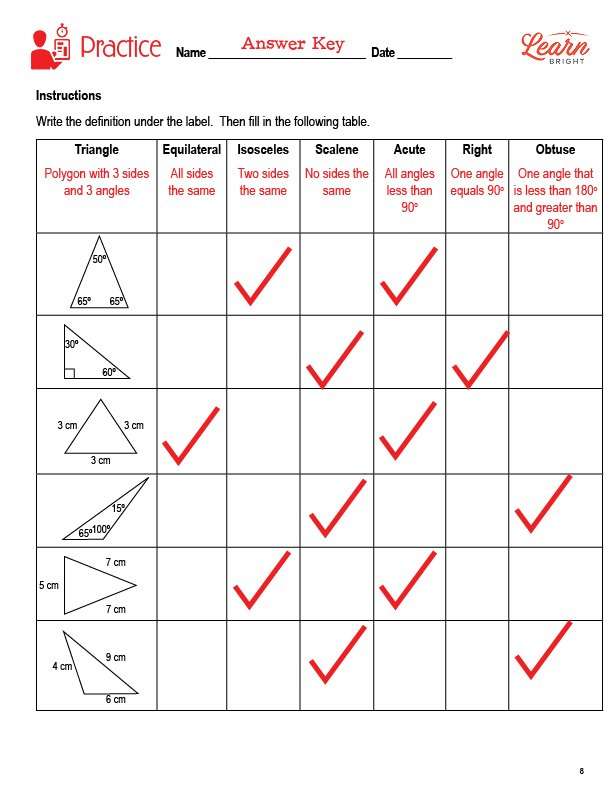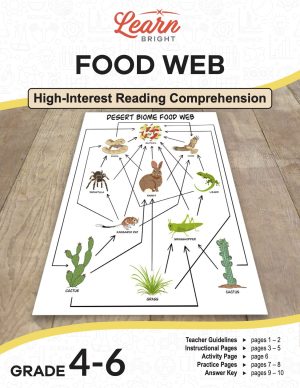Description
What our Classifying 2D Figures lesson plan includes
Lesson Objectives and Overview: Classifying 2D Figures introduces students to the process of identifying and classifying two-dimensional figures based on their properties. At the end of the lesson, students will be able to classify two-dimensional figures based on their properties. This lesson is for students in 5th grade and 6th grade.
Classroom Procedure
Every lesson plan provides you with a classroom procedure page that outlines a step-by-step guide to follow. You do not have to follow the guide exactly. The guide helps you organize the lesson and details when to hand out worksheets. It also lists information in the blue box that you might find useful. You will find the lesson objectives, state standards, and number of class sessions the lesson should take to complete in this area. In addition, it describes the supplies you will need as well as what and how you need to prepare beforehand. The supplies you will need for this lesson include scissors and glue.
Options for Lesson
Included with this lesson is an “Options for Lesson” section that lists a number of suggestions for activities to add to the lesson or substitutions for the ones already in the lesson. One optional adjustment to the lesson activity is to have your students sort their shapes and labels in the Venn Diagram without help from the teacher and see how many students get the correct placement before they glue them down. An optional addition to the lesson is to create cards for students to sort. You can ask your students what traits they would use the if they were going to sort and classify the shapes. Finally, you could have students write a story about a shape using its properties.
Teacher Notes
The teacher notes page includes lines that you can use to add your own notes as you’re preparing for this lesson.
CLASSIFYING 2D FIGURES LESSON PLAN CONTENT PAGES
Classifying 2D Figures – Triangles
The Classifying 2D Figures lesson plan includes two content pages. We classify polygons by their sides and angles. Mathematicians call the different characteristics that shapes have the properties of a figure. These focus on two categories: Properties of Sides and Properties of Angles.
Properties of Sides include descriptors like parallel (equidistant; the same distance apart), perpendicular (at right angles to the horizon or another object), congruency (having the same shape and size), and the number of sides that a figure contains. Properties of Angles include the angle measurement the congruency.
Closed plane figures with three lines and three angles are triangles. However, you can construct three lines and three angles in many different ways!
When you classify triangles, you can do so by sides and by angles. An equilateral triangle has three sides of the same length, an isosceles triangle has at least two sides of the same length, and a scalene triangle has no sides of the same length. A right triangle has one right angle (90 degrees), an acute triangle has three acute angles (less than 90 degrees), and an obtuse triangle has one obtuse angle (greater than 90 degrees).
Classifying 2D Figures – Quadrilaterals
Closed plane figures with four lines and four angles are quadrilaterals. You can draw closed figures with four lines and four angles in many different ways. We use properties of sides and properties of angles to classify quadrilaterals, but in a more in-depth way than with triangles. All enclosed polygons with four sides and four angles are quadrilaterals.
We group quadrilaterals by their parallel sides. They van have none, one, or two sets of parallel lines. If they don’t have any parallel lines, we classify them as a quadrilateral or a kite. If they have one set of parallel lines, we classify them as a trapezoid. Finally, if they have two sets of parallel lines, we classify them as a parallelogram.
We also group them by angles and sides. A parallelogram with four right angles is a rectangle. A parallelogram with four congruent sides is a rhombus. Squares are a special case, as they have both four congruent sides and four right angles. Squares are both a type of rectangle and a type of rhombus.
Because they all have two sets of parallel lines, all rectangles, rhombi, and squares are parallelograms. However, each of them has different features in their sides and angles. All parallelograms are quadrilaterals. Not all quadrilaterals are parallelograms.
CLASSIFYING 2D FIGURES LESSON PLAN WORKSHEETS
The Classifying 2D Figures lesson plan includes three worksheets: an activity worksheet, a practice worksheet, and a homework assignment. You can refer to the guide on the classroom procedure page to determine when to hand out each worksheet.
VENN DIAGRAM ACTIVITY WORKSHEET
The activity worksheet asks students to sort and classify the given quadrilaterals by their properties and paste them into the Venn Diagram on the worksheet.
TABLE PRACTICE WORKSHEET
For the practice worksheet, students will write the definition of each shape under its label. They will also fill in a table based on the characteristics of each shape.
CLASSIFYING 2D FIGURES HOMEWORK ASSIGNMENT
The homework assignment asks students to draw a picture of each quadrilateral under its label and then fill in the table, which asks whether each quadrilateral has different characteristics.
QUIZ
This lesson also includes a quiz that you can use to test students’ understanding of the lesson material. For the quiz, students will name 2D figures based on the listed properties.
Worksheet Answer Keys
This lesson plan includes answer keys for the practice worksheet, the homework assignment, and the quiz. If you choose to administer the lesson pages to your students via PDF, you will need to save a new file that omits these pages. Otherwise, you can simply print out the applicable pages and keep these as reference for yourself when grading assignments.









